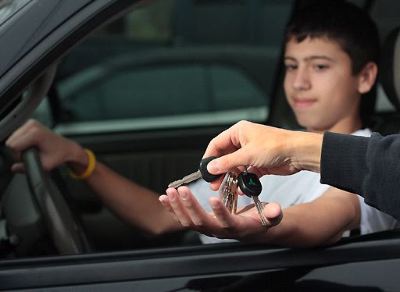
by Flagship Staff | Mar 6, 2017 | Blog
As a parent, you can expect your car insurance premiums to increase once your teen driver gets behind the wheel. In fact, adding a teenage driver to your policy can nearly double your premiums. Aside from encouraging your teenage child to take defensive driver lessons, follow these money-saving tips to cut down the cost of car insurance for teenagers.
1. Take advantage of multi-policy discounts
Getting your auto, home and life insurance from one company will not only save you time by having all your bills in one place, you can also save up to 25% on your policy by bundling your insurance policies.
2. Opt for higher deductibles
Having higher comprehensive and collision deductibles may increase your out-of-pocket expenses, but they can also save you hundreds of dollars by drastically reducing your overall premium. Taking advantage of Nationwide’s “Vanishing Deductible” option could help offset your higher deductible in the event of a claim.
3. Reward your child for good grades
If your teen driver is a full-time student with a B average or higher, they may be eligible for a good student discount. If the student is homeschooled, however, they must score in the top 20% of a standardized test such as the SAT.
4. Buy a safe and reliable car
High-end car models are more costly to insure, so opt for a more a practical vehicle equipped with safety features, such as anti-lock brake system (ABS), anti-theft devices and rearview cameras.
5. Get a pre-owned car
Car insurance rates for used cars are usually cheaper than new models, so forget that brand new SUV and drive away with a slightly older vehicle instead.
For a teenager, getting a driver’s license is a step towards independence, but it comes at the cost of higher insurance rates. By following the tips above and practicing safe driving habits, you can lower the cost of car insurance for your teenager.
Insurance terms, definitions and explanations are intended for informational purposes only and do not in any way replace or modify the definitions and information contained in individual insurance contracts, policies or declaration pages, which are controlling. Such terms and availability may vary by state and exclusions may apply. Discounts may not be applied to all policy coverages.
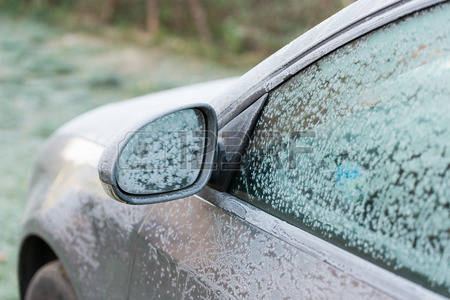
by Flagship Staff | Feb 27, 2017 | Blog
In the Midwest, coming out to a car covered in snow and ice is a common occurrence.
If you’re used to having your car buried in snow or covered with ice, here are some tips that can help you and your car survive the winter months.
1. Stand up your wipers. Lately, I’ve noticed more people doing this. If a winter storm is scheduled to start after you get to work, raise your windshield wipers off the glass. This will prevent them from being frozen to the windshield. Snow removal is much easier too. To take it a step further, you could cover your wipers with an old pair of socks or plastic grocery bags. Keeping snow and ice off your windshield wipers is important for a safe drive home.
2. Hand sanitizer. If you have an older car or a broken key fob, your door lock could freeze. If you have hand sanitizer with you, it’s your lucky day! Rub a small amount of hand sanitizer on the lock to melt the ice.
3. Frozen doors no more. Have you ever struggled to get a frozen car door open? If so, this could be a thing of the past. Cooking spray, which is a staple in most homes, can solve this problem. Gently apply cooking spray on the rubber around the door and the car frame to prevent freezing. Gently wipe off excess spray on the rubber with a paper towel or rag.
4. Scrapping side mirrors is a pain. If you don’t have heated side mirrors, scraping them can be difficult. As soon as you start scraping, the mirror moves. To prevent frosty side mirrors, cover them with a plastic bag. Make sure the bags are securely fastened with rubber bands.
5. Foggy windows are a pet peeve. Foggy, dirty windows drive us crazy in the winter. To help alleviate fog buildup on your windows, there are a number of tricks that can help.
Apply shaving cream and immediately wipe it off.
Buy Rain-X® Interior Glass Anti-Fog.
Fill an old sock with kitty litter and store it in your car. This trick will remove moisture from the air.
6. Apply Rain-X 2-in-1 glass cleaner with rain repellent. This cleaner works great! Not only does it clean your dirty salty windshield, it applies water beading technology. If your wipers make that awful noise in light rain or melting snow, Rain-X can help reduce the number of wipes and increase visibility.
7. Impenetrable windows. I’m sure you’ve experienced the impenetrable sheet of ice on your car. No matter how hard you try to scrape your windows, success is limited. To defeat the ice that prevents you from going where you need to go, simply mix a solution of 2/3 vinegar and 1/3 water. Put it in a spray bottle and spray it on the ice. It works like charm in melting the ice.
8. Stuck no more. 20 or 40 pounds of kitty litter stored in your trunk can serve several purposes. First, if placed over rear wheels, it can enhance traction. Second, if you deviated from the roadway and are now stuck, pour some of it out under your tires to help get traction. Cardboard or floor mats can also help get you back on the roadway. Simply place them under your tires.
Do you have any tips or information you’d like to share? I’d love to hear them; please share them in the box below.
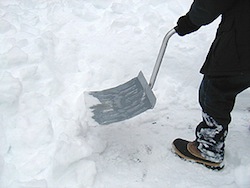
by Flagship Staff | Feb 20, 2017 | Blog
Let it snow, let it snow, let it snow. Now what?
Winter is here, and that undoubtedly means we’ll get snow. While it can create a winter wonderland and provide the perfect setting for a day of sledding or snowman building, it can also turn your sidewalks and driveways into hazardous areas.
When the snow hits, be sure to keep these tips in mind so you can enjoy your snow day.
1.Check your local ordinances about snow removal. You’re likely required to remove all snow on walkways within 24 hours of snow accumulation. If you’ll be out of town, make sure you arrange for someone to come to your property and take care of the snow removal for you.
2.Get yourself a present this year. Purchasing an ergonomic snow shovel can help avoid unnecessary strain to your body. Even fluffy snow can feel heavy when you have a lot of area to clear.
3.Salt freshly-cleared areas. When shoveling or snow blowing is complete, be sure to salt the freshly-cleared areas. A light dusting and freezing temperatures can turn quickly walkways into ice rinks. Driveways should get the salt treatment, as well. If you prefer, sand can be used instead of salt.
4.Keep the mail carrier and garbage/recycling collectors in mind too. Snowplows can make mailboxes and garbage/recycling bins difficult to access which makes their jobs that much harder.
Keeping your property safe is incredibly important if you want to avoid injury to a guest, passerby, or worker. If someone slips and falls on your property, you could be facing an insurance claim. The person who fell may also sue you. This is why it’s important to understand how your insurance policy works to keep your finances protected.
While your Homeowner’s Liability and Medical Payments coverages will respond if someone falls on your property and you’re found liable, will you have enough coverage? If your Homeowner’s Liability limit is at $100,000, you might not have enough coverage for all the medical expenses incurred by the person who fell. With the rising costs of hospital care, it’s best to review your policy with your insurance agent to make sure you have enough coverage.
If you don’t already have an Umbrella Liability policy, it’s a good time to look into purchasing one. If your Homeowner’s Liability coverage limit is met, but you still owe money, your Umbrella Liability policy will kick in and provide at least $1,000,000 of additional coverage.
If the chore of snow removal is too strenuous or you simply don’t want to do it, there are many professional snow removal services around. Give them a call and let them keep your property safe.
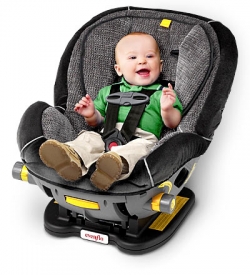
by Flagship Staff | Feb 13, 2017 | Blog
Today, safety experts recommend putting children in their car seats without their winter coats. Doesn’t this seem counter intuitive? After all, it is winter.
Recently on the “Today” show, Jeff Rossen did a segment on car seat dangers during the winter. He visited a crash test lab in Michigan. His segment shows the dramatic results of a car crash at 30 mph with a crash dummy inappropriately strapped in because of a puffy winter coat. Miriam Manary, who operates the lab, explains the proper way to strap in a child during the winter months. She recommends strapping them in without a coat. To keep them warm she suggests using a blanket or putting on their jacket backwards.
If you’re expecting your first child and haven’t picked out your car seat, check out the information at safercar.gov. Their website provides information on:
How to select the right car seat;
What safety ratings mean;
How to install your car seat; and
How to register your car seat and how to get recall notifications.
Consider ordering a TIKE (Toddler Info Kept for Emergencies) sticker to attach to your car seat. TIKE is a bright neon green sticker that includes a child’s emergency and medical contact information that goes on the car seat. This information in critical if you have an accident and you’re unable to help the first responders with the care of your child.

by Flagship Staff | Feb 6, 2017 | Blog
This is the time of year when ponds and lakes are frozen. Soon you’ll be getting ready to get your vehicle out on the open, frozen water to enjoy the great outdoors. But what would you do if the unthinkable – but sinkable – happens and your vehicle breaks through the ice?
How is your car covered if it breaks through the ice?
As long as you have comprehensive (other than collision) coverage on the auto, there’s actual cash value coverage for the auto. West Bend will also provide coverage for the retrieval cost of the vehicle’s extraction from the body of water.
What happens if your car does not have comprehensive coverage (other than collision)?
Your insurance may provide coverage for the retrieval costs of the vehicle’s extraction from the body of water as property damage under your auto liability coverage.
There’s no coverage for the cost of the vehicle itself. Any fines assessed to you for the car falling through the ice would also be paid by you.
What happens if your ATV, snowmobile, or other recreational vehicle breaks though the ice?
If your recreational vehicle carries physical damage coverage, it would be covered if it sinks. The deductible would apply. Your insurance company may also provide coverage for the retrieval costs of the recreational vehicle’s extraction from the body of water.
What happens if your ATV, snowmobile, or other recreational vehicle doesn’t have comprehensive coverage (other than collision)?
If you don’t have physical damage coverage on your recreational vehicle, your insurance may provide up to $1,000 of coverage for the recreational vehicle itself and the retrieval costs of the recreational vehicle’s extraction from the body of water.
Pollution and any other fines assessed to you for the recreational vehicle falling through the ice would be paid by you.
Before heading out on the ice
To keep you and your vehicle afloat, be sure to take the necessary safety precautions. First, check with your local bait shop or lakeside resort about ice conditions, then check the ice thickness when you get there.
Ice thickness guidelines:
2″ or less – STAY OFF!
4″ – Ice fishing or other activities on foot
5″ – Snowmobile or ATV
8″ – 12″ – Car or small pickup
12″ – 15″ – Medium truck
Remember, temperature, snow cover, currents, and springs all affect ice safety. Ice is rarely the same thickness over a single body of water; it can be two feet thick in one place and one inch thick a few yards away. Check the ice at least every 150 feet. Park cars, pickups, and sport utility vehicles at least 50 feet apart and move them every two hours to prevent sinking.
With common sense and precaution, you’ll keep your vehicles above water and enjoy a safe season outdoors!
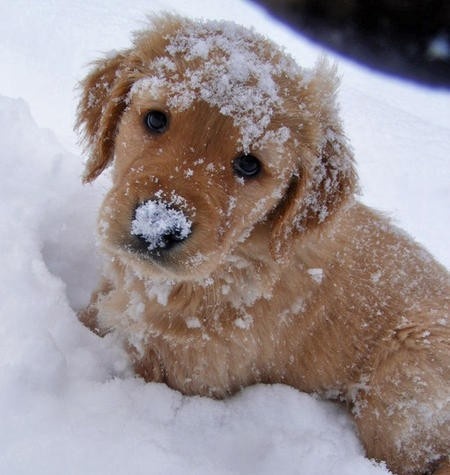
by Flagship Staff | Feb 1, 2017 | Blog
Do you have a new furry member in your family? Is this your first winter with them? If so, winter weather can be challenging for both of you.
Pets are a great addition to the family. They bring laughter and companionship to our lives. In return, most of us want to provide the best care we can to our beloved pets, and during the winter months, they may need a bit more care.
Here are some tips that can help you if you live in a Winter Wonderland.
1. Don’t zap your cat. A cat’s physiology, and its behavior, are different than dogs. Many dogs like to snuggle with you and enjoy it when you pet their heads or rub their bellies. On the other hand, while your cat may like to hang out you, he may not like being petted. The reason is static electricity. If you stroke a cat, from head to tail, this may aggravate him because static electricity builds up in his body. When we run the furnace in the winter, the static electricity in our home intensifies and can make your cat uncomfortable. Simply walking around the house can cause a zap if you touch your cat. If your cat likes to play on your furniture, he could be zapped.
To help control the zap factor in your home, run a humidifier. Keeping the humidity in your home between 20 and 50 percent can create a more comfortable environment.
If your cat tolerates water, spray a mister on his entire body to help eliminate static electricity.
Keep in mind that there are several benefits to installing a humidifier in your home even if you don’t have pets.
2. A good pair of boots. Depending on your level of activity during the winter, a good pair of boots can prevent cold feet and frostbite. If this is your first winter with your pet, don’t forget about their paws. Our pet’s paws can take a beating during the winter months. Check their paws frequently to make sure the paw pads aren’t cracked or bleeding.
3. Clean their boots. After a refreshing winter walk, it’s important to clean off their paws as soon as you return home. They may have picked up toxic chemicals or have sidewalk salt stuck between their toes. This is also a good time to check for injury or trauma to their paws. If you want to protect their paws or avoid cleaning them, booties are an option if they’ll wear them. Don’t forget to scrub their bellies as well!
4. Eliminate access to the garage. Our vehicles make a mess on the garage floor in the winter with slush and toxins from melting snow. If you have an older car, it may contain antifreeze that tastes sweet to our pets. Antifreeze, which is crucial to keeping our cars running, is extremely dangerous. If a small amount is ingested it can be fatal because it will lead to kidney failure.
If your pet has wandered into your garage and afterward, shows these symptoms, seek medical attention immediately. Medicine is available but must be given quickly after ingestion.
Symptoms of antifreeze poisoning
Staggering;
Lethargy;
Excessive drinking; and
Seizures.
Today, major marketers of antifreezes have changed the formula from a sweet taste to a bitter taste. Please be aware, however, that this doesn’t make antifreeze safer. It’s an attempt to keep them from ingesting large quantities.
If you notice an antifreeze leak in your garage or if you spill it, clean it up immediately. Using kitty litter is a safe way to soak it up. Use large amounts of water to rinse your floor.
5. Shovel your yard. While shoveling snow isn’t fun, it’s important to clear a spot in your yard for your pet. Some dogs hate going out in the snow and cold. An area free of snow and salt can make life easier for both of you. Also, consider accompanying them outside if it’s very cold. Using familiar verbal commands may keep them focused on what they’re supposed to do (i.e. “go potty” or “get busy”). A delicious treat afterward will help reward and reinforce their good behavior.
6. Cold cars are dangerous too. During the summer months, we hear news reports about the danger of leaving your child or pet in the car unattended. Winter can be just as dangerous. If you have to leave them unattended, it’s best to leave them at home.
7. Too cold for you? If you have multiple pets, each one may experience the cold weather differently. Pay attention. If one dog loves long walks and playing in the snow, let her at it. If your other dog is miserable, come up with a different routine for him. In the end, if it’s too cold for you, it’s probably too cold for them.
8. Wear reflective clothing. If you enjoy walking your dog before sunrise or after sunset, make sure both of you wear reflective clothing. Motorists don’t expect to see people out and about during the winter months. Even if you live in a well-lit neighborhood, it still may be difficult for motorists to see you.
9. Keep them on their leashes. City ordinances usually require your dog to be on leash when strolling through your neighborhood. If you normally give your pet some freedom and remove the leash, winter is not the time to do it. Snowfall can make it difficult for pets to find their way home if they get lost.






